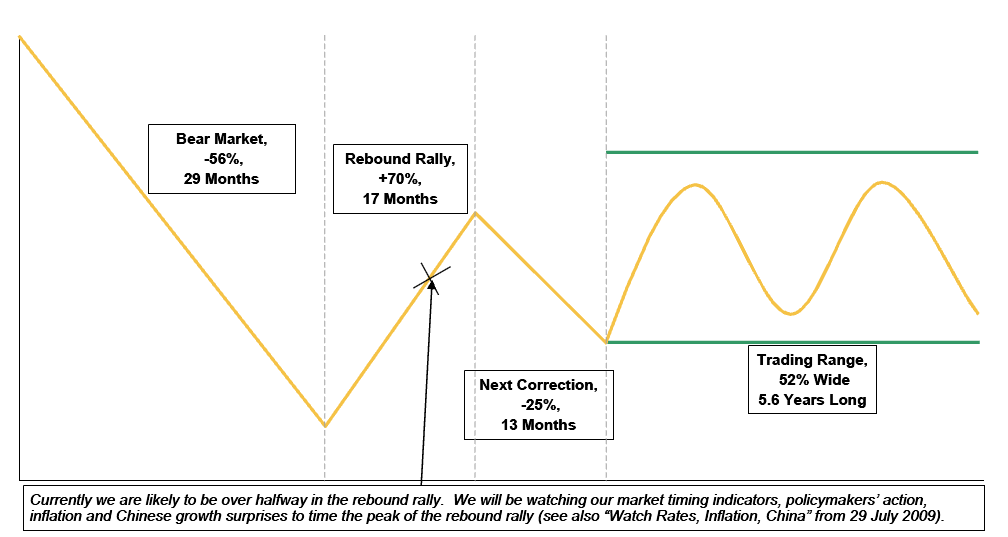...As grandmother used to say "Secular bear markets aren't just about declines [although they can be doozies], they're also about multiple contraction."This is important stuff, hence the soundtrack.
"Grandma, what's a doozie?"...
Just kidding, more self-referencing [reverencing? -ed] after the jump.
From the Financial Times:
David Stevenson: The three bears tell a cautionary tale
If you’re an enthusiastic equity investor and an eternal optimist by nature – as I am – be wary of spending an hour or two with Albert Edwards at Société Générale (SG). It can be highly enjoyable in conversational terms, but deeply depressing.
Edwards, an economist by training, works alongside chief quantitative analyst Andrew Lapthorne and strategist Dylan Grice – and, over the past decade, they’ve made themselves spectacularly unpopular with some City types as a result of their predictions of doom for equities.
And the trouble is that, so far, they’ve been right. Equities have had a dreadful few decades and bonds have kept on grinding ever higher in price, pushing yields ever closer to zero. So, a couple of weeks back, I caught up with the trio to ask them whether the time had finally come to embrace equities again....
...According to this bearish outlook, equities will keep falling as price/earnings (p/e) ratios tumble from the high teens to the low single digits. In this new Ice Age, margin compression as measured by the p/e will be long and painful. In a word: Japanese.
Sadly, this multi-year bear market is far from over, according to Edwards, who says we are not yet at “rock bottom,” where p/e ratios will be in the single digits....The whole thing is worth a read and a bookmark.
...“I think if you look at any sensible measure – be it long term measures like the Shiller p/e [a measure of the long term p/e ratio over 10 years], and the dividend yield, then I think you’re in the expensive camp [for equities]. And I think you’re looking at a real returns freeze over the next 10 years as well.
“If you just add up the dividend yield on the market, which is about 2 per cent, and add in say 1 per cent real dividend growth, you’re at around 3 per cent. Anything else you’ll get is from multiple expansion [ie rising p/e ratios], which I can’t really see happening from these kind of levels.” ...
...Paradoxically, though, Edwards is fairly optimistic about what may come next – “actually I’m far more optimistic on a 10-year view for equities, than I have been for the last 10 years”.
The deconstruction of expected returns and the equity risk premium are topics that Robert Arnott, former editor of the Financial Analysts Journal knows something about. Some of our earlier Arnott posts:
What Risk Premium Is “Normal”?
I said earlier today, in "Will Green Investors Demand Higher Risk Premia?" that the short answer was yes and that I would expand (expound) on this idea. First though, it might be useful to link to a couple old pros, Robert Arnott and Peter Bernstein. If you know this stuff, this is a good brush-up, if you don't, this is a very readable 22 page PDF.
Up and Down Wall Street: Rob Arnott "After Lost Decade, It's Still Tough to Find Returns "
The goal of this article is an estimate of the objective forward-looking U.S. equity risk premium relative to bonds through history—specifically, since 1802. For correct evaluation, such a complex topic requires several careful steps: To gauge the risk premium for stocks relative to bonds, we need an expected real stock return and an expected real bond return. To gauge the expected real bond return, we need both bond yields and an estimate of expected inflation through history. To gauge the expected real stock return, we need both stock dividend yields and an estimate of expected real dividend growth. Accordingly, we go through each of these steps. We demonstrate that the long-term forward-looking risk premium is nowhere near the level of the past; today, it may well be near zero, perhaps even negative....
Equity Risk Premium: "Why the market’s rate of return—and your nest egg—may never recover"
A Really Smart Guy On Stocks, Bonds and Expected Returns
On P/E contraction we've had:
Four Stages of a Secular Bear Market
...Typical Secular Bear Market and Its Aftermath

"P/E Expansion & Contraction"
This is a point you must understand if you are to have any hope of making money in the market longer term.Markets: Of Bulls and Bears, Secular and Observant
And a point we've belabored for three years, use the 'Search blog' box, key word secular.
From The Big Picture:
Yesterday, Peter Boockvar referenced two WSJ articles on P/E: The Decline of the P/E Ratio and Is It Time to Scrap the Fusty Old P/E Ratio?
I believe these articles are asking the wrong question. Rather than wondering if the value of P/E ratio is fading, the better question is, “What does a falling P/E ratio mean?” The chart below will help answer that question....
...Previously on Blossom:Death of the American Dream? (nah)
Julian Robertson: US To Face Poor Economy for 10-15 Years (And Warren Buffett Stops By)
December 31, 1964: DJIA 874.12Where in the Bear are We?
December 31, 1981: DJIA 875.00
"Now I'm known as a long-term investor and a patient guy, but that is not my idea of a big move."
-Warren Buffett
In this 1999 Fortune article "Mr. Buffett on the Stock Market". Granted the time and tape he was talking about was even worse...
Dow Chart with P/E, 105 Years
click for larger chart

Markets: Is This Bull Cyclical or Secular?
Best strategy for long bear market 2010-2020
Gail Dudack on What's Ahead for the Stock Market
Stock markets – secondary or primary bull?
Shiller: "Seven More Years of Hard Times?"
And many more.